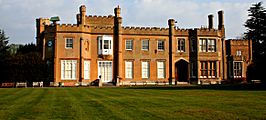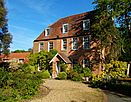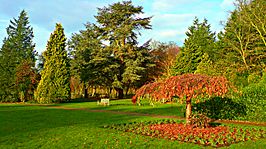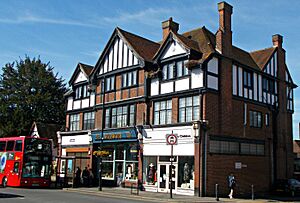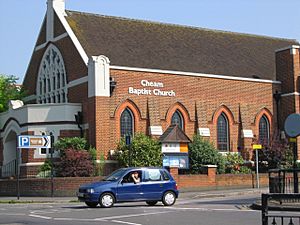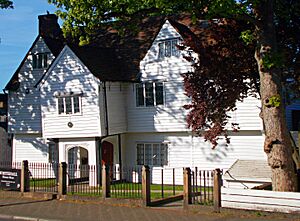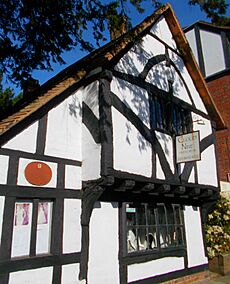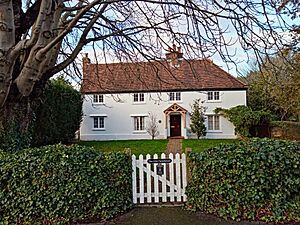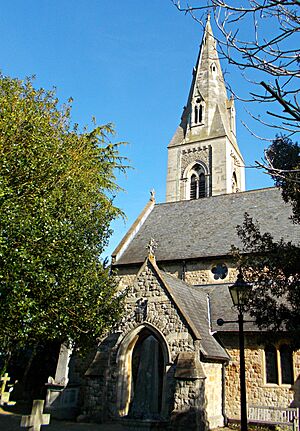Cheam facts for kids
Quick facts for kids Cheam |
|
|---|---|
|
Top to bottom, left to right: Grade II listed Nonsuch Mansion in Nonsuch Park; The Old Rectory, Cheam; Whitehall during Cheam Charter Fair; Nonsuch Park
|
|
| Population | 10,285 (2011 Census. Ward) |
| OS grid reference | TQ245625 |
| London borough | |
| Ceremonial county | Greater London |
| Region | |
| Country | England |
| Sovereign state | United Kingdom |
| Post town | SUTTON |
| Postcode district | SM2, SM3 |
| Dialling code | 020 |
| Police | Metropolitan |
| Fire | London |
| Ambulance | London |
| EU Parliament | London |
| UK Parliament |
|
| London Assembly |
|
Cheam (pronounced cheem) is a lively area in London, England. It's located about 10.9 miles (17.5 km) southwest of Charing Cross, a famous spot in central London. Cheam is split into three main parts: North Cheam, Cheam Village, and South Cheam.
Cheam Village is home to old buildings like Lumley Chapel and Whitehall, which dates back to the 1500s. You'll also find two big parks nearby: Nonsuch Park and Cheam Park. Nonsuch Park has a beautiful old house called Nonsuch Mansion. Some parts of Cheam Park and Cheam Village are special "conservation areas," meaning they are protected for their history and beauty.
Cheam is surrounded by other towns and areas. To the northwest is Worcester Park, to the northeast is Morden, and to the east is Sutton. To the west, you'll find Epsom, Ewell, and Stoneleigh. To the south are Banstead and Belmont.
Contents
History of Cheam
Cheam has a long and interesting history! A very old Roman road called Stane Street forms part of Cheam's border. Today, the modern London Road in North Cheam follows the path of this ancient Roman road. It's now known as the A24.
Early Cheam: Anglo-Saxons and Domesday Book
Long ago, in Anglo-Saxon times, Cheam was part of an area called Wallington hundred. The name 'Cheam' might mean 'village or home by the tree-stumps'.
Cheam is even mentioned in the famous Domesday Book, which was a big survey of England made in 1085-1086. In the Domesday Book, Cheam was called Ceiham. It was owned by Archbishop Lanfranc of Canterbury. The survey noted that Cheam had four "hides" (an old way to measure land), one church, 17 ploughs (for farming), one mile of meadow, and woodland worth 25 hogs. It brought in £14 in income.
Medieval Times and Royal Connections
In the Middle Ages, Cheam was known for its pottery. Archaeologists have even found evidence of these old potteries. In 1259, King Henry III of England gave Cheam a special charter, which officially made it a town.
Later, in 1538, a part of Cheam was given to King Henry VIII of England. That same year, Henry VIII started building a very fancy palace nearby called Nonsuch Palace. It was decorated in a very elaborate way, but sadly, it was later sold and taken down.
By 1801, when the first official count of people (census) happened, Cheam had 616 residents.
Cheam was also the first home of Cheam School, a famous school that started in Whitehall in 1645. It moved to a new building in 1719 and then to Berkshire in 1934. Even Prince Philip went to Cheam School just before it moved!
Cheam Charter Fair
Every year on May 15th, Cheam celebrates the Cheam Charter Fair. People think this fair started way back in 1259, when King Henry III made Cheam a town. We know for sure that the fair has been happening since the 1800s, when it included fun fairground rides along with a market.
Cheam Village and North Cheam Areas
Exploring Cheam Village
Cheam Village is the heart of the area, located at a crossroads connecting Sutton, North Cheam, South Cheam, and Ewell.
It's a special conservation area with many historic buildings that are hundreds of years old. These include Nonsuch Mansion, the unique gabled Whitehall, Lumley Chapel, and an old Georgian rectory.
The Cheam Village Conservation Area was created in 1970. It protects the old parkland, different styles of houses, and a shopping area that looks like old Tudor buildings with timber details. The entrances to Cheam Park and Nonsuch Park, with its historic mansion, are just a short walk from the village center.
Discovering North Cheam
North Cheam is about 1 mile (1.6 km) north of Cheam Village. It's also centered around a crossroads, connecting Cheam Village with Worcester Park, Epsom, and Morden. This central spot is called Victoria Junction.
North Cheam has a large Sainsbury's supermarket with a Starbucks inside. You'll also find a park, many local shops and restaurants, a 24-hour McDonald's drive-thru, a post office, and a Costa Coffee. There are plans to update some older buildings here to add more shops and homes. St. Anthony's Hospital, a large private hospital, is also in North Cheam.
For sports and fun, Cheam Leisure Centre on Malden Road offers a swimming pool, squash courts, and a fitness gym.
Places to See in Cheam
Whitehall House
Whitehall is a special house in Cheam Village. It's built with a timber frame and covered with wooden boards. It was first built around 1500 as a farmer's house, but it has been made bigger over time. The wooden boards on the outside were added in the 1700s. In the garden, there's a medieval well that was used by an even older building on the same spot.
Today, Whitehall is a museum where you can see how people lived in the Georgian, Victorian, and Edwardian eras. It has a kitchen that looks just like it would have back then. The museum was closed for a big update in 2016 and reopened in June 2018 with new and improved areas.
Cheam War Memorial
Near Cheam Library and the local church, you'll find the Cheam War Memorial. This memorial honors the people from Cheam who lost their lives in World War I, World War II, and the Falklands War.
It has several messages carved into it, including one that says: "Our Glorious Dead / Their names shall endure for evermore." This memorial was recognized as a special historic building in December 2016.
The Old Rectory
The Old Rectory is a large house with some timber framing. It was built during the Tudor period but was made bigger and changed in the 1700s. Sometimes, it is open for the public to visit.
The Old Cottage
The Old Cottage was built a long time ago, in the late 1400s or early 1500s. It started as a small house and later became a small brewery in the 1700s. It used to be on a different street, but when the road was made wider in 1922, it was going to be torn down. Luckily, the local council and a historian saved it!
The building was carefully taken apart, piece by piece, by removing the old wooden pins that held its frame together. Then, all the parts were moved about 100 yards (91 meters) down the road and put back together again. The Old Cottage now has a plaque telling its history. It used to be a shop for wedding dresses and is now a wool shop.
The Old Farmhouse
The Old Farmhouse is another large, old house with timber framing and wooden boards on the outside. It's part of the Cheam Conservation Area, along with St Dunstan's Church, Whitehall, The Old Rectory, and Lumley Chapel. The oldest part of the house dates back to the 1400s, with additions made in the 1500s and 1600s.
Many original features are still there, like oak doors, old hinges, window shutters, and fireplaces. You can see a lot of the wooden frame inside the house. Recent digging even found a large Tudor kitchen hidden underneath the house! You can find more information about this house in the Conservation Archive at Sutton Library.
Nonsuch Mansion
Nonsuch Mansion is a beautiful old house in Nonsuch Park. It's built in a style called Gothic revival. You can visit the Service Wing Museum inside the mansion on Sundays during the summer. This museum is run by a group called the Friends of Nonsuch. They also have a large model of the original Nonsuch Palace, which you can see on Sundays.
The mansion is a popular place for weddings and events. In medieval times, the land where Nonsuch Mansion stands was part of a huge estate called Cuddington. The mansion was first built between 1731 and 1743 by Joseph Thompson. Later, in 1799, Samuel Farmer bought it and had it rebuilt in a Tudor Gothic style between 1802 and 1806.
Nonsuch Mansion looks a bit like the original Nonsuch Palace that King Henry VIII started building in the 1500s. Inside the mansion's front porch, there's even a stone block from the original Nonsuch Palace. It has an inscription that means "1543 Henry VIII in the 35th year of His reign."
Places of Worship
Cheam has several places of worship. St Dunstan's Church is the main church for the area, located in Cheam Village next to Lumley Chapel. St Paul's Howell Hill is on Northey Avenue, known for its modern design. St Andrew's United Reformed Church, also on Northey Avenue, is a historic building designed in 1933. Cheam Baptist Church is right next to St Dunstan's. Cheam Methodist Church is in the east of town and also hosts Sutton Schoolswork, a local charity that works with schools.
St Dunstan's Church
St Dunstan's Church is a very important historic building. It was built in Cheam Village in 1864, right next to Lumley Chapel, on the site of an even older medieval church. It's made of strong stone with slate roofs and special stone details around the windows and doors. The church was designed in the Gothic revival style. The entrance gate to the churchyard, built in 1891, is also a historic landmark. There are three historic tombs in the churchyard.
Archaeological work has been carried out in the churchyard. In the 1980s, the church was home to a youth club called 'The Shed'.
Lumley Chapel
Lumley Chapel is next to St Dunstan's Church and is the oldest building still standing in the London Borough of Sutton. It holds many important monuments to local families from long ago.
When the new St Dunstan's church was built in 1864, the old church on the site was mostly taken down. However, the east end of the old church was kept to hold the monuments and brass plaques. This remaining part is now known as Lumley Chapel. It's built with stone and brick and has a gabled tile roof. The window at the east end is from the 1400s.
In 2002, the chapel was given to the Churches Conservation Trust, a charity that looks after historic churches. It's considered a very important historic building.
Parks and Gardens in Cheam
Even though Cheam is a built-up area, it has two wonderful green spaces: Cheam Park and Nonsuch Park.
Nonsuch Park is home to the historic Nonsuch Mansion, which has a cafe and beautiful flower gardens. Nonsuch Park also stretches into nearby Stoneleigh and East Ewell.
Cheam Park offers tennis courts, football pitches, and a playground for children. There's also a cafe in the middle of the park where you can grab a snack.
Schools in Cheam
Cheam has many schools for students of all ages.
For girls, there's Nonsuch High School, which is a grammar school. Cheam High School is a large mixed school for both boys and girls.
Primary schools in the area include Cuddington Croft, St Cecilias Catholic Primary School, Cheam Fields Primary, Cheam Common Primary, Cheam Park Farm Nursery and Infants School, Cheam Park Farm Juniors, Nonsuch Primary, and St. Dunstans Church of England Primary.
Getting Around Cheam
Cheam has its own train station, Cheam station, which is on the lines between Sutton and Epsom. It's in Travelcard Zone 5. You can catch direct trains from Cheam to central London, reaching Victoria station in about 30 minutes.
There were once plans to extend the London Underground's Northern line to North Cheam in 1946, but this extension never happened.
Cheam and North Cheam are also served by several bus routes. These include the 213 (Sutton to Kingston), 151 (Wallington to Worcester Park), 93 (North Cheam to Putney Bridge), and the SL7 service, which connects Heathrow Airport to Croydon.
Cheam in Pop Culture
Cheam has appeared in popular culture!
In the old comedy show Hancock's Half Hour, the main character, Tony Hancock, lived on a fictional road called Railway Cuttings in "East Cheam." While East Cheam isn't an official area today, it did exist in old census records from 1841.
Cheam is also mentioned in a fun rhyme that dates back to the 1700s: "Sutton for good mutton; Cheam for juicy beef; Croydon for a pretty girl And Mitcham for a thief."
St. Dunstan's Church was used as a filming location for an episode of the TV comedy The I.T. Crowd. Also, scenes from the show Made in Chelsea were filmed at Nonsuch Mansion.
Notable People from Cheam
Many interesting people have connections to Cheam:
- James Blades (1901–1999) was a famous musician who played percussion in orchestras.
- Jane Dee, who was a lady-in-waiting to Queen Elizabeth I, was born in Cheam.
- Comedian Tony Hancock (1924–1968) lived in Cheam and even set his comedy sketches there.
- Film director Paul Greengrass (born 1955) was born in Cheam.
- Formula One racing driver James Hunt (1947–1993) lived in Cheam as a child.
- Darts players Peter Manley (born 1962) and Jimmy Mann (born 1978) have connections to Cheam.
- Joanna Rowsell (born 1988), an Olympic gold medalist in cycling, went to school in Cheam. Her achievement was celebrated with a special gold postbox in Cheam Village.
- Actor Alex Sawyer (born 1993) lived in Cheam for a while.
- Comedian Harry Secombe (1921–2001) lived in Cheam for many years.
- Former England cricketer Alec Stewart (born 1963) lived in Cheam.
- Presenter Jeremy Vine (born 1965) and his brother, comedian Tim Vine (born 1967), were born in Cheam.
- Actress Carrie Quinlan and historian Suzannah Lipscomb (born 1978) both lived in Cheam and attended Nonsuch High School for Girls.
Nearby Places
 |
Worcester Park, Motspur Park | Lower Morden, Raynes Park | Morden, Mitcham, St Helier |  |
| Stoneleigh | Sutton, Carshalton | |||
| Ewell | Banstead, Nork | Belmont |
Images for kids
See also
 In Spanish: Cheam para niños
In Spanish: Cheam para niños


